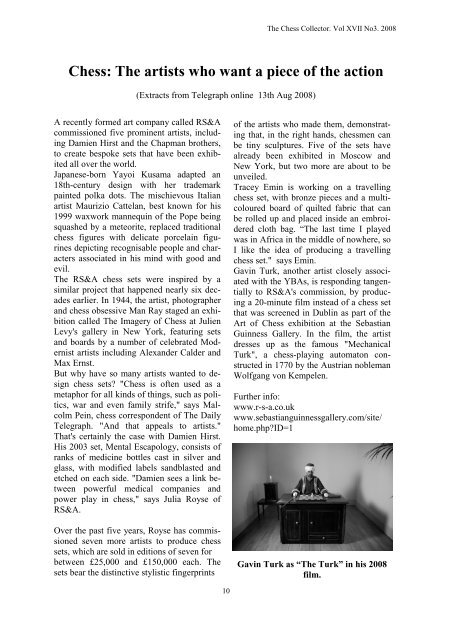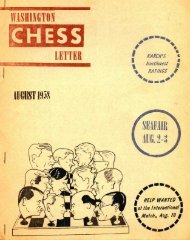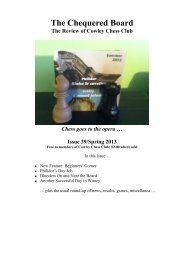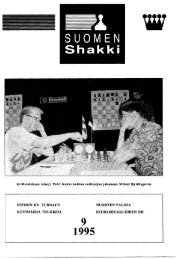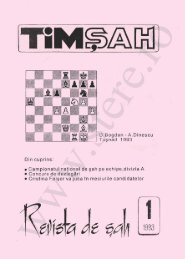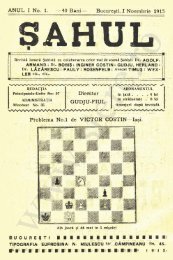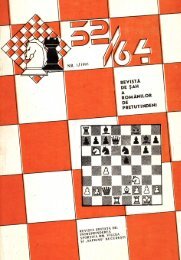The Chess Collector
El ajedrez es un juego, considerado un deporte, entre dos personas, cada una de las cuales dispone de 16 piezas móviles que se colocan sobre un tablero dividido en 64 escaques. En su versión de competición está considerado como un deporte.
El ajedrez es un juego, considerado un deporte, entre dos personas, cada una de las cuales dispone de 16 piezas móviles que se colocan sobre un tablero dividido en 64 escaques. En su versión de competición está considerado como un deporte.
You also want an ePaper? Increase the reach of your titles
YUMPU automatically turns print PDFs into web optimized ePapers that Google loves.
<strong>The</strong> <strong>Chess</strong> <strong>Collector</strong>. Vol XVII No3. 2008<br />
<strong>Chess</strong>: <strong>The</strong> artists who want a piece of the action<br />
(Extracts from Telegraph online 13th Aug 2008)<br />
A recently formed art company called RS&A<br />
commissioned five prominent artists, including<br />
Damien Hirst and the Chapman brothers,<br />
to create bespoke sets that have been exhibited<br />
all over the world.<br />
Japanese-born Yayoi Kusama adapted an<br />
18th-century design with her trademark<br />
painted polka dots. <strong>The</strong> mischievous Italian<br />
artist Maurizio Cattelan, best known for his<br />
1999 waxwork mannequin of the Pope being<br />
squashed by a meteorite, replaced traditional<br />
chess figures with delicate porcelain figurines<br />
depicting recognisable people and characters<br />
associated in his mind with good and<br />
evil.<br />
<strong>The</strong> RS&A chess sets were inspired by a<br />
similar project that happened nearly six decades<br />
earlier. In 1944, the artist, photographer<br />
and chess obsessive Man Ray staged an exhibition<br />
called <strong>The</strong> Imagery of <strong>Chess</strong> at Julien<br />
Levy's gallery in New York, featuring sets<br />
and boards by a number of celebrated Modernist<br />
artists including Alexander Calder and<br />
Max Ernst.<br />
But why have so many artists wanted to design<br />
chess sets? "<strong>Chess</strong> is often used as a<br />
metaphor for all kinds of things, such as politics,<br />
war and even family strife," says Malcolm<br />
Pein, chess correspondent of <strong>The</strong> Daily<br />
Telegraph. "And that appeals to artists."<br />
That's certainly the case with Damien Hirst.<br />
His 2003 set, Mental Escapology, consists of<br />
ranks of medicine bottles cast in silver and<br />
glass, with modified labels sandblasted and<br />
etched on each side. "Damien sees a link between<br />
powerful medical companies and<br />
power play in chess," says Julia Royse of<br />
RS&A.<br />
Over the past five years, Royse has commissioned<br />
seven more artists to produce chess<br />
sets, which are sold in editions of seven for<br />
between £25,000 and £150,000 each. <strong>The</strong><br />
sets bear the distinctive stylistic fingerprints<br />
of the artists who made them, demonstrating<br />
that, in the right hands, chessmen can<br />
be tiny sculptures. Five of the sets have<br />
already been exhibited in Moscow and<br />
New York, but two more are about to be<br />
unveiled.<br />
Tracey Emin is working on a travelling<br />
chess set, with bronze pieces and a multicoloured<br />
board of quilted fabric that can<br />
be rolled up and placed inside an embroidered<br />
cloth bag. “<strong>The</strong> last time I played<br />
was in Africa in the middle of nowhere, so<br />
I like the idea of producing a travelling<br />
chess set." says Emin.<br />
Gavin Turk, another artist closely associated<br />
with the YBAs, is responding tangentially<br />
to RS&A's commission, by producing<br />
a 20-minute film instead of a chess set<br />
that was screened in Dublin as part of the<br />
Art of <strong>Chess</strong> exhibition at the Sebastian<br />
Guinness Gallery. In the film, the artist<br />
dresses up as the famous "Mechanical<br />
Turk", a chess-playing automaton constructed<br />
in 1770 by the Austrian nobleman<br />
Wolfgang von Kempelen.<br />
Further info:<br />
www.r-s-a.co.uk<br />
www.sebastianguinnessgallery.com/site/<br />
home.php?ID=1<br />
Gavin Turk as “<strong>The</strong> Turk” in his 2008<br />
film.<br />
10


